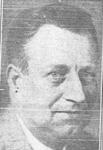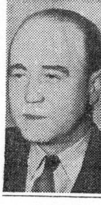The Founders
Four men from two real estate firms were responsible for the development of Forest Lawn Memorial Park. Denny Peters and Earl McBride from Peters and McBride joined Raymond Book and Paul Ludt from The Book-Ludt Organization to form the Parkland Development Company around 1930. Their original plans were to acquire land for a housing project. The land was purchased. Then the “Great Depression” hit, the housing market collapsed and they were forced into changing their plans or lose everything. The redirection of plans brought about the cemetery. Below is information on the founders.

Denny T. Peters (Feb 9, 1891 – Aug 4, 1975)
Denny was the longest-serving founder. He was active in the cemetery until his death in 1975. Of the founders, he is the most documented (see buttons below). He was a community leader. Denny and his family (including an infant son who died in 1919 prior to the development of the cemetery) are interned in the cemetery.
Earl M. McBride (Apr 20, 1886 – Apr 6, 1951)
Earl was the eldest founder and has been credited with the idea of using the land for a new type of cemetery. He was the first founder to die and was active in the cemetery until his death. Earl and his family are interned in the cemetery.


Raymond F. Book (Jan 29, 1895 – Jan ?, 1968)
Ray remained active in the cemetery until April 1953 when he was not reelected to the board. As early as 1941, there are records that indicate that he had moved away from the area to Chevy Chase, Maryland, and later to Dover, Delaware. From what we can determine, Ray is interned in Lakeside Cemetery in Dover, Delaware.
Paul M. Ludt (Mar 26, 1895 – Oct 1, 1954)
Paul is the least documented founder. There is little information nor photos of Paul. He was the first founder to stop his activity with the cemetery. In 1942, he was not reelected to the board. His name was not listed in the 1937-38 city directory so he probably left the area and relocated to Chevy Chase, Maryland and later to Bethesda, Maryland. The is no information on where Paul is interned.
The Designers & Builders
The founders set out to create a cemetery that was different from the traditional cemeteries of the period. They wanted it to be unique, special and an asset to the area. To accomplish their goal they sought out the best people available to work on the project. Both local and nonlocal were used. Information on the designers and builders has been obtained from newspaper articles, cemetery maps, pictures, and documents. Below is what we have been able to find on the people and firms who used on the project.
Architect
Munroe Copper was a prominent Cleveland architect who did a significant amount of work in the Youngstown area. He was responsible for designing a majority of the homes in Forest Glen and several area churches. Copper designed the front entrance, chapel, and original features.
Landscape Designers
The layout of the cemetery’s roadways and grounds, and landscaping is credited to the firm of Pitkins & Mott of Cleveland. Additional landscaping was later added by Carol Lawrence of Flint, Michigan. Both were nationally known for their work.
Engineering
The civil engineering work was performed by an engineer from Youngstown—Albert Haenny.
Stone Masons & Builders
Felix Pesa and his firm performed stone mason work throughout the cemetery. They constructed the front entrance and features from both the 1930s and 1950s. Felix was killed in a traffic accident in 1934.
The Hadlock Krill Company of Cleveland, Ohio constructed the chapel. The firm is still in operation and operating under the name of The Krill Company.
